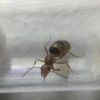- Formiculture.com
- Forums
- Gallery
- Members
- Member Map
- Chat

Central Florida, 5/18/2022
Started By
FloridaAnts
, May 18 2022 3:12 PM

Best Answer Manitobant , May 18 2022 - 3:22 PM
Solenopsis invicta queen. Xyloni has been extinct in florida (and the rest of the southeast US) for more than half a century.
Go to the full post 
4 replies to this topic
#1
 Offline
-
Posted May 18 2022 - 3:12 PM
Offline
-
Posted May 18 2022 - 3:12 PM
1. Location (on a map) of collection: Central Florida
2. Date of collection: Wednesday, May 18th
3. Habitat of collection: Driveway, urbanized neighborhood
4. Length (from head to gaster): About 10mm
5. Color, hue, pattern and texture: Head is red, thorax is red-black, gaster is orange where petiole connects, but midway the color changes to reddish black.
6. Distinguishing characteristics: Normal queen ant, but doesn’t seem to be Solenopsis invicta due to thorax pattern
7. Distinguishing behavior: Found with wings, the queen later removed them
8. Nest description: (I don’t know where the nest is!)
9. Nuptial flight time and date: around 3:30, May 18th.
Note: I have heard Solenopsis invicta has a orange V shape in the thorax(I have seen queens with this) this queen does not. Genetic variation or Solenopsis Xyloni?
2. Date of collection: Wednesday, May 18th
3. Habitat of collection: Driveway, urbanized neighborhood
4. Length (from head to gaster): About 10mm
5. Color, hue, pattern and texture: Head is red, thorax is red-black, gaster is orange where petiole connects, but midway the color changes to reddish black.
6. Distinguishing characteristics: Normal queen ant, but doesn’t seem to be Solenopsis invicta due to thorax pattern
7. Distinguishing behavior: Found with wings, the queen later removed them
8. Nest description: (I don’t know where the nest is!)
9. Nuptial flight time and date: around 3:30, May 18th.
Note: I have heard Solenopsis invicta has a orange V shape in the thorax(I have seen queens with this) this queen does not. Genetic variation or Solenopsis Xyloni?
#2
 Offline
-
Posted May 18 2022 - 3:22 PM
Best Answer
Offline
-
Posted May 18 2022 - 3:22 PM
Best Answer
Solenopsis invicta queen. Xyloni has been extinct in florida (and the rest of the southeast US) for more than half a century.
Edited by Manitobant, May 18 2022 - 3:28 PM.
- James C. Trager and FloridaAnts like this
My journals:
Polyergus Mexicanus: https://www.formicul...gs/#entry175528
Lasius minutus: https://www.formicul...cs/#entry174811
Lasius latipes: https://www.formicul...gs/#entry206449
General acanthomyops journal: https://www.formicul...yops-with-eggs/
Polyergus Mexicanus: https://www.formicul...gs/#entry175528
Lasius minutus: https://www.formicul...cs/#entry174811
Lasius latipes: https://www.formicul...gs/#entry206449
General acanthomyops journal: https://www.formicul...yops-with-eggs/
#3
 Offline
-
Posted May 18 2022 - 3:39 PM
Offline
-
Posted May 18 2022 - 3:39 PM
This is definitely S. invicta.
Hi there! I went on a 6 month or so hiatus, in part due, and in part cause of the death of my colonies.
However, I went back to the Sierras, and restarted my collection, which is now as follows:
Aphaenogaster uinta, Camponotus vicinus, Camponotus modoc, Formica cf. aserva, Formica cf. micropthalma, Formica cf. manni, Formica subpolita, Formica cf. subaenescens, Lasius americanus, Manica invidia, Pogonomyrmex salinus, Pogonomyrmex sp. 1, Solenopsis validiuscula, & Solenopsis sp. 3 (new Sierra variant).
#4
 Offline
-
Posted May 18 2022 - 3:46 PM
Offline
-
Posted May 18 2022 - 3:46 PM
Any recent reports of The southern fire ant? Or are they basically gone…(Anywhere not just Florida)Solenopsis invicta queen. Xyloni has been extinct in florida (and the rest of the southeast US) for more than half a century.
I’ll keep it, due to the fact the one other time I had invicta the queen had nanitics, and she never laid any more eggs despite protein and carbohydrates feedings given to the workers. Also, not sure if it’s normal, but she got physo-gastric in the test tube after tearing off her wings
Edited by FloridaAnts, May 18 2022 - 3:51 PM.
#5
 Offline
-
Posted May 18 2022 - 4:11 PM
Offline
-
Posted May 18 2022 - 4:11 PM
solenopsis xyloni are super common in the desert regions of the southwestern united states, where it is too dry for invicta to survive long term. In the east, xyloni has been completely wiped out by invicta, which fill a very similar niche but do it much better.Any recent reports of The southern fire ant? Or are they basically gone…(Anywhere not just Florida)Solenopsis invicta queen. Xyloni has been extinct in florida (and the rest of the southeast US) for more than half a century.
I’ll keep it, due to the fact the one other time I had invicta the queen had nanitics, and she never laid any more eggs despite protein and carbohydrates feedings given to the workers. Also, not sure if it’s normal, but she got physo-gastric in the test tube after tearing off her wings
My journals:
Polyergus Mexicanus: https://www.formicul...gs/#entry175528
Lasius minutus: https://www.formicul...cs/#entry174811
Lasius latipes: https://www.formicul...gs/#entry206449
General acanthomyops journal: https://www.formicul...yops-with-eggs/
Polyergus Mexicanus: https://www.formicul...gs/#entry175528
Lasius minutus: https://www.formicul...cs/#entry174811
Lasius latipes: https://www.formicul...gs/#entry206449
General acanthomyops journal: https://www.formicul...yops-with-eggs/
1 user(s) are reading this topic
0 members, 1 guests, 0 anonymous users













